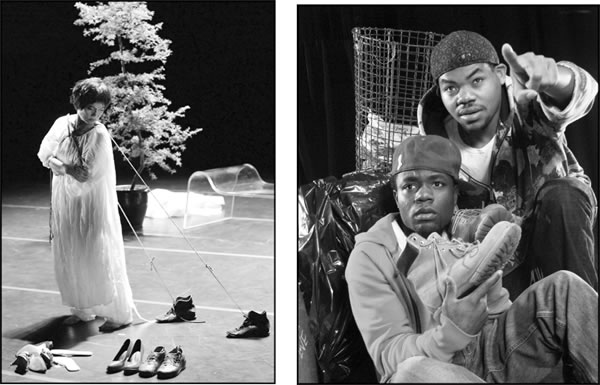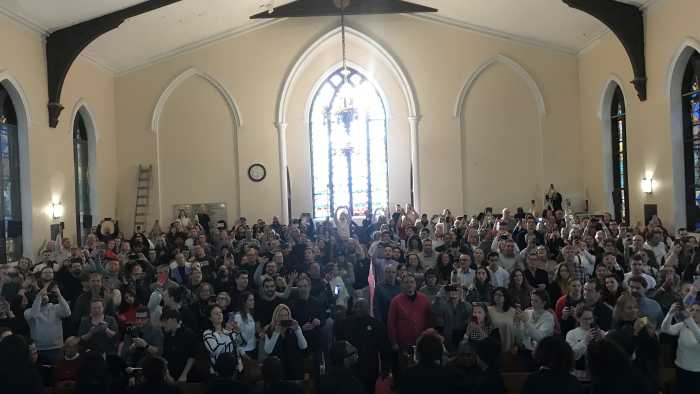By JERRY TALLMER
ESTRAGON: (turning to look at the boots). I’m leaving them there. (Pause.) Another will come just as we … as … as me, but with smaller feet, and they’ll make him happy.
VLADIMIR: But you can’t go barefoot!
ESTRAGON: Christ did.
VLADIMIR: Christ! What has Christ got to do with it? You’re not going to compare yourself to Christ!
ESTRAGON: All my life I’ve compared myself to him.
VLADIMIR: But where he lived it was warm, it was dry!:
ESTRAGON: Yes, And they crucified quick.
— Samuel Beckett, Waiting for Godot
“Shoes!” said Sin Cha Hong. “Shoes! Boots! Lots of shoes! In this dance I play with them. Each one has a different memory. And I use a rope; two ropes” – the one that Estragon (a/k/a Gogo) thinks of hanging himself with, though it’s not strong enough to support the weight of both him and Vladimir (a/k/a Didi); and the longer rope that connects the hand of Pozzo to the neck of his slave, the overburdened silent Lucky,
Speaking of which, the caustic New York morning-after reviewers, notably Mr. Walter Kerr, who wanted to write Samuel Beckett and “Godot” off in 1956 as pretentious claptrap, are a bit out of luck.
Few if any other plays in all this world have been performed so often or so widely around that world in the slightly more than half century since Samuel Beckett wrote it, and in fact “Waiting for Godot” is right now slated to come back to Broadway next April with Bill Irwin and Nathan Lane as Didi and Gogo under the direction of Anthony Page.
I might just add that the only thing I liked about the showy, gimmicky “Godot” Mike Nichols, Steve Martin, and Robin Williams gave us at the Mitzi Newhouse in 1988 was Bill Irwin as Lucky.
More immediately, we have hard upon us two new and very different Off-Off-Broadway great-grandchildren of “Godot.” To be more exact, two manifestations inspired by “Waiting for Godot” but very different from that drama itself.
One is Korea-born Sin Cha Hong’s solo dance piece, simply called “Godot,” November 20 to 30 at Ellen Stewart’s La MaMa E.T.C. on East 4th Street.
The other, already on the boards is an all-black (three men and one woman) hip-hop-influenced play called “For Flow,” by a 28-year-old Brooklynite named Kesav M. Wable, who grew up first in South India, then in New Jersey.
Indeed, from almost the day it was written “Waiting for Godot” has impacted strongly on black people, there, here, everywhere, who know in their bones a lot about waiting. There have been quite a number of black productions of it in this city and elsewhere, from Harlem to Broadway, but none more gutsy than the “Godot” of Gilbert Moses and John O’Neal’s Free Southern Theater that toured the tiny communities of the rural black South during the civil-rights struggles of the early 1960s.
The title “For Flow” becomes a little clearer if you expand it in your mind to “Waiting for Flow” while you observe two black would-be hiphop impresarios, Dee and Kane, waiting under a lonely lamppost in the Bronx for the arrival of a record producer named Flow who might boost them on to fame and fortune. But instead there comes along a tough-talking young woman with a baby carriage full of her recordings that she wants to hock to pay for food.
“I was living in Brooklyn and acting and going to law school,” says Wable – he is now a lawyer – “and listening to hip-hop and rappers, when I picked out of the bookcase a copy of ‘Waiting for Godot’ that I’d had in college, and started reading it while listening to the music.
“Then the first line of the play came into my head: the character named Dee reading from a magazine about music and clubs and street life, and saying: ‘What the hell do these writers know about the streets?’ ”
His parents, Suresh and Sumathi Wable, are medical people – his father an E.R. doctor, his mother a radiologist. When Kesav was 10 they moved from India to just outside Newark, where he became friends with “a mixed crowd – Hispanics, Poles, Indians, blacks, middle-class white families.”
No, he has never seen “Waiting for Godot” except for a BBC tape. He did see John Turturro in Beckett’s “Endgame” at BAM.
Following a 2002 BA in Political Science from Haverford College, Pennsylvania, going to law school was “a pragmatic decision – “to provide for a family if I have one.” Prathima Narayan, his girlfriend, a dancer, may have something to say about that.
Dance takes us back to Sin Cha Hong, a diminutive but most distinctive woman who cradles her forehead in her hands as she says of her interpretation of the Beckett: “There is a tree. I use the tree. I also relate to the tree.”
Choreographer, singer, writer, dancer Hong has been ranked alongside Isadora Duncan and Vaslav Nijinski by one of China’s leading dance critics. She’s lived and worked in New York for the 20 years from 1970 to 1990, has a 1966 degree in Dance from Columbia University, worked with such as John Cage and Nam June Park, is founder of the Stone Dance Theater, and has appeared many times at La MaMa.
“This is the first time anyone anywhere ever did a ‘Waiting for Godot’ in dance,” she says.
And what does “Godot” mean to you, Ms. Hong?
Temple in hands. Thought, thought. Then:
“Despair. And, like, meaninglessness. Waiting, waiting, just waiting.” Pause. “But if there’s no waiting, I don’t think people can live. Because you have to have something to look forward to.”
So you wait. If Godot won’t appear, at least Samuel Beckett will, on paper and on stage.
FOR FLO. By Kesav M. Wable. Directed by Jonathan Solari. With Devere Rogers, Vladimi Versailles, Cherrye Davis, Brian D. Coats. A 25 to Life production through November 23 at Theater for the New City, 155 First Avenue, (646) 621-7891.
GODOT. A dance drama by Sin Cha Hong, inspired by the play by Samuel Beckett. November 20 to November 30 at La MaMa E.T.C., 74-A East 4th Street, (212) 475-7710.







































